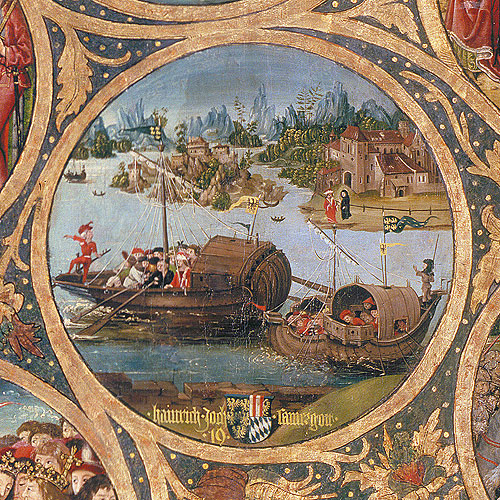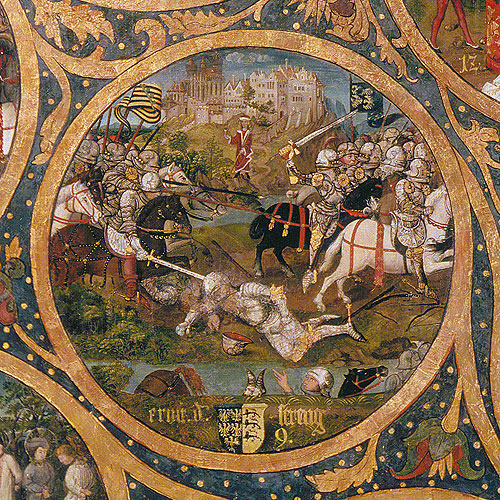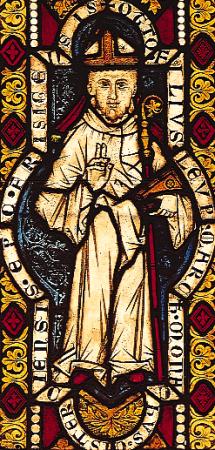|
Henry II Of Austria
Henry II (german: Heinrich; 1107 – 13 January 1177), called Jasomirgott, a member of the House of Babenberg,Lingelbach 1913, pp. 91–92. was Count Palatine of the Rhine from 1140 to 1141, Duke of Bavaria (as ''Henry XI'') and Margrave of Austria from 1141 to 1156, and the first Duke of Austria from 1156 until his death. Family Henry was the second son of Margrave Leopold III of Austria, the first from his second marriage with Agnes of Waiblingen, a sister of the last Salian emperor, Henry V. Leopold himself was expected to stand as a candidate in the 1125 election as king of Germany; nevertheless, he renounced in favour of his step-son (and Henry's half-brother), the Hohenstaufen duke Frederick II of Swabia, who eventually lost against Lothair of Supplinburg. Among Henry's younger brothers were Bishop Otto of Freising and Archbishop Conrad II of Salzburg. His sister Judith became the wife of Marquess William V of Montferrat. Henry's nickname, ''Jasomirgott'', was first doc ... [...More Info...] [...Related Items...] OR: [Wikipedia] [Google] [Baidu] |
Duke Of Austria
This is a list of people who have ruled either the Margraviate of Austria, the Duchy of Austria or the Archduchy of Austria. From 976 until 1246, the margraviate and its successor, the duchy, was ruled by the House of Babenberg. At that time, those states were part of the Holy Roman Empire. From 1246 until 1918, the duchy and its successor, the archduchy, was ruled by the House of Habsburg. Following the defeat of Austria-Hungary in World War I, the titles were abolished or fell into abeyance with the erection of the modern Republic of Austria. Margraves of Austria The March of Austria, also known as ''Marcha Orientalis'', was first formed in 976 out of the lands that had once been the March of Pannonia in Carolingian times. The oldest attestation dates back to 996, where the written name "ostarrichi" occurs in a document transferring land in present-day Austria to a Bavarian monastery. House of Babenberg , width=auto, Leopold I the Illustrious(''Luitpold der Erlauchte'' ... [...More Info...] [...Related Items...] OR: [Wikipedia] [Google] [Baidu] |
List Of Rulers Of Austria
This is a list of people who have ruled either the Margraviate of Austria, the Duchy of Austria or the Archduchy of Austria. From 976 until 1246, the margraviate and its successor, the duchy, was ruled by the House of Babenberg. At that time, those states were part of the Holy Roman Empire. From 1246 until 1918, the duchy and its successor, the archduchy, was ruled by the House of Habsburg. Following the defeat of Austria-Hungary in World War I, the titles were abolished or fell into abeyance with the erection of the modern Republic of Austria. Margraves of Austria The March of Austria, also known as ''Marcha Orientalis'', was first formed in 976 out of the lands that had once been the March of Pannonia in Carolingian times. The oldest attestation dates back to 996, where the written name "ostarrichi" occurs in a document transferring land in present-day Austria to a Bavarian monastery. House of Babenberg , width=auto, Leopold I the Illustrious(''Luitpold der Erlauchte'') ... [...More Info...] [...Related Items...] OR: [Wikipedia] [Google] [Baidu] |
Rhenish Franconia
Rhenish Franconia (german: Rheinfranken) or Western Franconia () denotes the western half of the central Kingdom of Germany, German stem duchy of Franconia in the 10th and 11th century, with its residence at the city of Worms, Germany, Worms. The territory located on the banks of Rhine river roughly corresponded with the present-day States of Germany, state of Hesse and the adjacent Palatinate (region), Palatinate region in the south. History The Franconian stem duchy, part of former Frankish Austrasia, was seized by King Otto I, Holy Roman Emperor, Otto I of Germany after the unsuccessful revolt of the Conradines, Conradine duke Eberhard of Franconia, Eberhard had shattered at the 939 Battle of Andernach. With the advancement of Count Conrad, Duke of Lorraine, Conrad the Red, Rhenish Franconia became the heartland of the Imperial Salian dynasty, which provided four emperors in the 11th and 12th centuries: Conrad II, Holy Roman Emperor, Conrad II, Henry III, Holy Roman Emperor, H ... [...More Info...] [...Related Items...] OR: [Wikipedia] [Google] [Baidu] |
Middle High German
Middle High German (MHG; german: Mittelhochdeutsch (Mhd.)) is the term for the form of German spoken in the High Middle Ages. It is conventionally dated between 1050 and 1350, developing from Old High German and into Early New High German. High German is defined as those varieties of German which were affected by the Second Sound Shift; the Middle Low German and Middle Dutch languages spoken to the North and North West, which did not participate in this sound change, are not part of MHG. While there is no ''standard'' MHG, the prestige of the Hohenstaufen court gave rise in the late 12th century to a supra-regional literary language (') based on Swabian, an Alemannic dialect. This historical interpretation is complicated by the tendency of modern editions of MHG texts to use ''normalised'' spellings based on this variety (usually called "Classical MHG"), which make the written language appear more consistent than it actually is in the manuscripts. Scholars are uncertain ... [...More Info...] [...Related Items...] OR: [Wikipedia] [Google] [Baidu] |
William V Of Montferrat
William V of Montferrat (occ./piem. ''Guilhem'', it. ''Guglielmo'') ( 1115 – 1191) also known regnally as William III of Montferrat while also referred to as William the Old or William the Elder, in order to distinguish him from his eldest son, William Longsword, was seventh Marquis of Montferrat from 1135 to his death in 1191. William was the only son of Marquis Renier I and his wife Gisela, a daughter of Count William I of Burgundy and widow of Count Humbert II of Savoy. It seems likely, given that he was still fit enough to participate in battle in 1187, that William was one of his parents' youngest children. He was described by Acerbo Morena as of medium height and compact build, with a round, somewhat ruddy face and hair so fair as to be almost white. He was eloquent, intelligent and good-humoured, generous but not extravagant. Dynastically, he was extremely well connected: a nephew of Pope Callixtus II, a half-brother of Amadeus III of Savoy whose daughter, Matil ... [...More Info...] [...Related Items...] OR: [Wikipedia] [Google] [Baidu] |
Judith Of Babenberg
Judith (or Jutta, sometimes called ''Julitta'' or ''Ita'' in Latin sources; c. 1115/1120 – after 1168), a member of the House of Babenberg, was Marchioness of Montferrat from 1135 until her death, by her marriage with Marquess William V. Life Judith was a daughter of Margrave Leopold III of Austria (1073–1136), from his second marriage with Agnes (1072–1143), the only daughter of the Salian emperor Henry IV. During 1133, Judith married the Aleramici marquess William V of Montferrat. The Aleramici were among the leading dynasties in the Crusades; William accompanied his nephew King Louis VII of France on the Second Crusade of 1147. Marriage and issue Judith and William had: *William Longsword (d. 1177), Count of Jaffa and Ascalon; father of Baldwin V of Jerusalem. *Conrad of Montferrat (d. 1192), King of Jerusalem *Boniface of Montferrat (d. 1207); his successor to Montferrat and founder of the Kingdom of Thessalonica. *Frederick of Montferrat, Bisho ... [...More Info...] [...Related Items...] OR: [Wikipedia] [Google] [Baidu] |
Conrad II, Archbishop Of Salzburg
Conrad of Babenberg (c. 1115 – 28 September 1168) was a nobleman and prelate of the Holy Roman Empire. He was the bishop of Passau (as Conrad I) from 1148/1149 until 1164 and then archbishop of Salzburg (as Conrad II) until his death, although he lost control of Salzburg when he was placed under the imperial ban in 1166.Heinrich von Zeißberg: Konrad II. In: ''Allgemeine Deutsche Biographie'' (ADB). Band 16, Duncker & Humblot, Leipzig 1882, p.615–617. Conrad came from the House of Babenberg. His father, Leopold III, was the Margrave of Austria, while his mother, Agnes of Waiblingen, was the daughter of the Emperor Henry IV. Prior to her marriage to Leopold, Agnes was married to Frederick I, Duke of Swabia, of the House of Hohenstaufen. Through Frederick, she was the mother of one king of Germany and grandmother of another: Cornad III (1138–52) and Frederick I (1152–90), Conrad of Babenberg's half-brother and nephew, respectively. One of Conrad's full brothers, Otto, becam ... [...More Info...] [...Related Items...] OR: [Wikipedia] [Google] [Baidu] |
Otto Of Freising
Otto of Freising ( la, Otto Frisingensis; c. 1114 – 22 September 1158) was a German churchman of the Cistercian order and chronicled at least two texts which carries valuable information on the political history of his own time. He was Otto I Bishop of Freising as from 1138. Otto participated in the Second Crusade; he lived through the journey and reached Jerusalem, and later returned to Bavaria in the late 1140s, living for another decade back in Europe. Life Otto was born in Klosterneuburg as the fifth son of Leopold III, margrave of Austria, by his wife Agnes, daughter of the emperor Henry IV. By her first husband, Frederick I of Hohenstaufen, duke of Swabia, Agnes was the mother of the German king Conrad III and grandmother of the emperor Frederick I. Otto's sister, Judith or Ita, was married to Marquess William V of Montferrat. Otto was thus related to the most powerful families in Germany and northern Italy. The records of his life are scanty and the dates ... [...More Info...] [...Related Items...] OR: [Wikipedia] [Google] [Baidu] |
Lothair Of Supplinburg
Lothair III, sometimes numbered Lothair II and also known as Lothair of Supplinburg (1075 – 4 December 1137), was Holy Roman Emperor from 1133 until his death. He was appointed Duke of Saxony in 1106 and elected King of Germany in 1125 before being crowned emperor in Rome. The son of the Saxon count Gebhard of Supplinburg, his reign was troubled by the constant intriguing of the Hohenstaufens, Duke Frederick II of Swabia and Duke Conrad of Franconia. He died while returning from a successful campaign against the Norman Kingdom of Sicily. Rise to power In 1013, a certain Saxon nobleman named ''Liutger'' was mentioned as a count in or of the Harzgau subdivision of Eastphalia. His grandson Count Gebhard, father of Emperor Lothair, possibly acquired the castle of Süpplingenburg about 1060 via his marriage with Hedwig, a daughter of the Bavarian count Frederick of Formbach and his wife Gertrud, herself a descendant of the Saxon margrave Dietrich of Haldensleben who secon ... [...More Info...] [...Related Items...] OR: [Wikipedia] [Google] [Baidu] |
Frederick II Of Swabia
Frederick II (1090 – 6 April 1147), called the One-Eyed, was Duke of Swabia from 1105 until his death, the second from the Hohenstaufen dynasty. His younger brother Conrad was elected King of the Romans in 1138. Life Early career Frederick II was the eldest son of Duke Frederick I of Swabia and his wife Agnes of Waiblingen, a daughter of the Salian emperor Henry IV. He succeeded his father in 1105 and together with his brother Conrad continued the extension and consolidation of the Hohenstaufen estates. Frederick had numerous castles erected along the Rhine river and in the Alsace region. Frederick accompanied King Henry V on his campaign against King Coloman of Hungary in 1108. In 1110, he and Henry V embarked on an expedition to Italy, where in Rome Henry enforced his coronation by Pope Paschal II. In turn, the emperor appointed Conrad Duke of Franconia and both brothers German regents when he left for his second Italian campaign in 1116, who put down a revolt by Ar ... [...More Info...] [...Related Items...] OR: [Wikipedia] [Google] [Baidu] |
Hohenstaufen
The Hohenstaufen dynasty (, , ), also known as the Staufer, was a noble family of unclear origin that rose to rule the Duchy of Swabia from 1079, and to royal rule in the Holy Roman Empire during the Middle Ages from 1138 until 1254. The dynasty's most prominent rulers – Frederick I (1155), Henry VI (1191) and Frederick II (1220) – ascended the imperial throne and also reigned over Italy and Burgundy. The non-contemporary name of 'Hohenstaufen' is derived from the family's Hohenstaufen Castle on the Hohenstaufen mountain at the northern fringes of the Swabian Jura, near the town of Göppingen. Under Hohenstaufen rule, the Holy Roman Empire reached its greatest territorial extent from 1155 to 1268. Name The name Hohenstaufen was first used in the 14th century to distinguish the 'high' (''hohen'') conical hill named Staufen in the Swabian Jura (in the district of Göppingen) from the village of the same name in the valley below. The new name was only applied to the h ... [...More Info...] [...Related Items...] OR: [Wikipedia] [Google] [Baidu] |
King Of Germany
This is a list of monarchs who ruled over East Francia, and the Kingdom of Germany (''Regnum Teutonicum''), from the division of the Frankish Empire in 843 and the collapse of the Holy Roman Empire in 1806 until the collapse of the German Empire in 1918. Note on titles #The Kingdom of Germany started out as the eastern section of the Frankish kingdom, which was split by the Treaty of Verdun in 843. The rulers of the eastern area thus called themselves ''rex'' ''Francorum'' ("king of the Franks"), ''rex Francorum orientalium'' ("king of the East Franks"), and later just ''rex''. A reference to the "Germans", indicating the emergence of a German nation of some sort, did not appear until the eleventh century, when the pope referred to his enemy Henry IV as ''rex teutonicorum'', king of the Germans, in order to brand him as a foreigner. The kings reacted by consistently using the title ''rex Romanorum'', king of the Romans, to emphasize their universal rule even before becoming ... [...More Info...] [...Related Items...] OR: [Wikipedia] [Google] [Baidu] |








